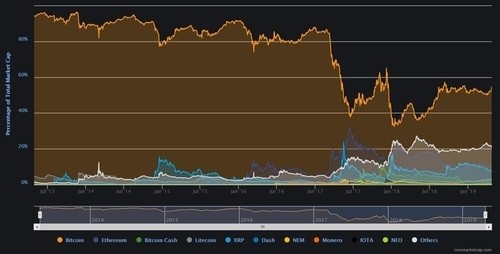Over the past week or so, Bitcoin’s market cap dominance has been rising along with its price. In other words, Bitcoin’s price multiplied by its supply of issued coins is rising relative to other coins:
Notably, Bitcoin’s market cap value is verging on the psychologically-significant $100 billion mark. If it passes through this level, Bitcoin’s rising dominance may accelerate due to the cachet of a 12 digit market cap value. A tenth of a trillion in market cap is impressive, even to a central banker!
While market cap is an inaccurate metric in many cases (given that large tranches of supply are frequently held off-market, or issued at will by centralized coins), it nonetheless gives a clear visual indication that Bitcoin is outperforming most other coins at this time.
If this trend continues, might Bitcoin regain the lion’s share of market value, as in its pre-2017 glory days of 80% plus dominance? Well, some people certainly hope so.
Enter the Bitcoin Maximalists
If you’re active on any crypto-related social media platforms, particularly Twitter, there’s a good chance you’ll have encountered the term “Bitcoin maximalist.” This somewhat-loaded term is usually aimed at zealous Bitcoin supporters, often by equally-zealous altcoin supporters. But what constitutes a Bitcoin maximalist?
The term “Bitcoin maximalist” was coined in November of 2014 by Ethereum’s famous co-founder (and former Bitcoin all-star), Vitalik Buterin. Writing on the Ethereum blog (apparently in response to criticism of Ethereum), Buterin said:
“Bitcoin dominance maximalism […] essentially, the idea that an environment of multiple competing cryptocurrencies is undesirable, that it is wrong to launch “yet another coin,” and that it is both righteous and inevitable that the Bitcoin currency comes to take a monopoly position in the cryptocurrency scene.”
When Buterin wrote these words, Bitcoin was entrenched in a clear monopoly position, with around 91% of market cap value. In 2014, most Bitcoiners did not consider altcoins as a credible threat to Bitcoin’s continued monopoly. They saw altcoins as either experiments (real money test-beds for new crypto tech and incentive structures, which may yield useful developments which can then be incorporated by Bitcoin); distractions (from the critical task of developing Bitcoin’s code and economy so that it can mount an effective challenge to the status quo monetary system); inflationary (by increasing the total supply of cryptocurrency); or outright scams (which many turned out to be, in hindsight).
However, by January of 2018, Bitcoin had fallen to its all-time market dominance low of about 33%, with Ethereum claiming its highest ever market cap dominance value of 22% around the same time.
After the publication of his article, Vitalik’s neologism was quickly adopted and henceforth used, often in a disparaging way, to refer to someone displaying a strong preference for Bitcoin over altcoins. Eventually, many Bitcoiners came to embrace the term as both a badge of honor and an accurate description of their beliefs. As a contrary term, this article proposes “crypto pluralists.”
Why Maximalists are Maximalists
As Vitalik acknowledged in his original article, Bitcoin’s dominance encompasses far more than price. While the desirability of this situation is debatable, it can’t be denied that Bitcoin currently leads the crypto industry. Here are some other key areas in which Bitcoin reigns supreme:
1) Network Effects
Bitcoin has by far the highest share of crypto users. This is important as the network effect rules that the more people using a service, the higher the value of that service becomes. For example, a social network with only 1 user would be pointless, whereas a platform with billions of users verges on becoming essential.
In traditional monetary terms, the US Dollar, benefiting (perhaps unduly) from its dominant status as the international reserve currency, becomes the most widely-accepted currency on the planet. A tourist could probably exchange American Dollars for a meal in most countries, whereas Angolan Kwanzas (or even Canadian Dollars) are unlikely to be accepted outside that country.
While it makes sense for countries to use their own currency internally but trade internationally using US Dollars, it has yet to be determined whether Bitcoin, as a single universal currency for online use, is preferable to multiple “internet monies.” Such unknowns are what drive the debate between Bitcoin maximalists and crypto pluralists.
2) Network Security
By dint of its formidable hashrate (currently over 41 quintillion hash calculations per second), Bitcoin’s blockchain is by far the most secure against 51% attacks and other network attacks. Furthermore, Bitcoin has the highest number of network nodes, at around 9407 reachable full nodes at the time of writing. More nodes protects against centralization factors.
As each hash calculation and each node has a cost, the minimum expense to 51% attack various blockchains can be estimated, as per the Crypto51 site:

The Bitcoin maximalist position is that alts divert hashpower which would otherwise be directed towards Bitcoin, thus diminishing the network’s security. Coins which don’t rely on Proof of Work (which is to say; hashpower) for security are obviously excluded from this argument. From the above chart, the cost to 51% attack Bitcoin would be nearly $10 million per day – a tidy sum but not beyond the capacity of certain actors.
The response of a crypto pluralist might be that Bitcoin’s network security is irrelevant to the crypto space as a whole. However, should Bitcoin be successfully attacked, the consequences to the entire crypto space can hardly be overstated. Bitcoin is the best (and perhaps only-known) example of a cryptocurrency to most members of the general public. Should any breach of Bitcoin become headline news, the damage to the public perception of cryptocurrency would be immense.
Furthermore, the prices of all cryptocurrencies are so strongly correlated to Bitcoin (at an average correlation of 0.78, where 1 is perfect correlation) that research from Binance calls Bitcoin the “bellwether of the industry.” Should Bitcoin’s security be broken, it’s inevitable that the entire industry would suffer. Should Bitcoin fail, it’s even possible that it’d take down the entire industry with it.
3) Monetary Hardness
One of the key economic differentiators between Bitcoin and fiat currency is that Bitcoin’s supply is limited to 21 million coins. Whereas a central bank can issue more fiat currency at will, thus diluting the value of all savings and pre-existing money, Bitcoin is immune from such inflationary practices… Or is it?
Maximalists have long argued that the creation of altcoins is a form of inflation, which drives down demand for Bitcoin by increasing the supply of alternate cryptocurrencies. Yet the crypto-pluralist argument says that the existence of altcoins, in fact, drives up demand for Bitcoin. Altcoins have the potential to appeal to those outside of Bitcoin’s usual demographic, and also have appeal to newcomers thanks to their lower price-point. But due to Bitcoin’s wide availability, the easiest way for a holder of altcoins to sell, is to first convert them to Bitcoin, thus increasing Bitcoin demand.
Maximalism or Pluralism?
All controversy aside, what all this probably boils down to for a new entrant to the crypto space—who doesn’t have a dog in the fight—is whether they should buy Bitcoin, some altcoin(s), or a combination thereof.
Neither maximalists nor pluralists get to decide which coin(s) will emerge victorious, and that’s a good thing. In a free market, the winner will be determined by the voluntary buying and selling activity of countless participants. Bitcoin is likely to stay on top for as long as it continues to provide superior monetary utility, but that doesn’t mean there isn’t room and need for altcoins.



